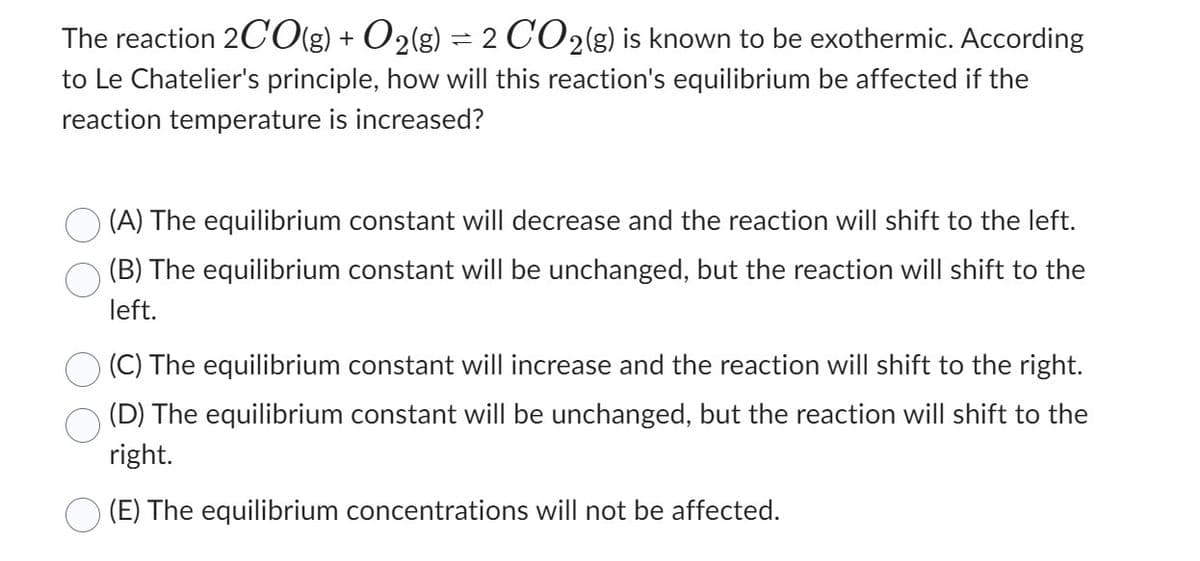The reaction 2CO(g) + O2(g) = 2 CO2(g) is known to be exothermic. According to Le Chatelier's principle, how will this reaction's equilibrium be affected if the reaction temperature is increased? (A) The equilibrium constant will decrease and the reaction will shift to the left. (B) The equilibrium constant will be unchanged, but the reaction will shift to the left. (C) The equilibrium constant will increase and the reaction will shift to the right. (D) The equilibrium constant will be unchanged, but the reaction will shift to the right. (E) The equilibrium concentrations will not be affected.
The reaction 2CO(g) + O2(g) = 2 CO2(g) is known to be exothermic. According to Le Chatelier's principle, how will this reaction's equilibrium be affected if the reaction temperature is increased? (A) The equilibrium constant will decrease and the reaction will shift to the left. (B) The equilibrium constant will be unchanged, but the reaction will shift to the left. (C) The equilibrium constant will increase and the reaction will shift to the right. (D) The equilibrium constant will be unchanged, but the reaction will shift to the right. (E) The equilibrium concentrations will not be affected.
Chemistry by OpenStax (2015-05-04)
1st Edition
ISBN:9781938168390
Author:Klaus Theopold, Richard H Langley, Paul Flowers, William R. Robinson, Mark Blaser
Publisher:Klaus Theopold, Richard H Langley, Paul Flowers, William R. Robinson, Mark Blaser
Chapter18: Representative Metals, Metalloids, And Nonmetals
Section: Chapter Questions
Problem 52E: The reaction of calcium hydride, CaH2, with water can be characterized as a Lewis acid-base...
Related questions
Question
100%

Transcribed Image Text:The reaction 2CO(g) + O2(g) = 2 CO2(g) is known to be exothermic. According
to Le Chatelier's principle, how will this reaction's equilibrium be affected if the
reaction temperature is increased?
(A) The equilibrium constant will decrease and the reaction will shift to the left.
(B) The equilibrium constant will be unchanged, but the reaction will shift to the
left.
(C) The equilibrium constant will increase and the reaction will shift to the right.
(D) The equilibrium constant will be unchanged, but the reaction will shift to the
right.
(E) The equilibrium concentrations will not be affected.
Expert Solution
This question has been solved!
Explore an expertly crafted, step-by-step solution for a thorough understanding of key concepts.
This is a popular solution!
Trending now
This is a popular solution!
Step by step
Solved in 2 steps

Knowledge Booster
Learn more about
Need a deep-dive on the concept behind this application? Look no further. Learn more about this topic, chemistry and related others by exploring similar questions and additional content below.Recommended textbooks for you

Chemistry by OpenStax (2015-05-04)
Chemistry
ISBN:
9781938168390
Author:
Klaus Theopold, Richard H Langley, Paul Flowers, William R. Robinson, Mark Blaser
Publisher:
OpenStax

Chemistry & Chemical Reactivity
Chemistry
ISBN:
9781337399074
Author:
John C. Kotz, Paul M. Treichel, John Townsend, David Treichel
Publisher:
Cengage Learning

Chemistry & Chemical Reactivity
Chemistry
ISBN:
9781133949640
Author:
John C. Kotz, Paul M. Treichel, John Townsend, David Treichel
Publisher:
Cengage Learning

Chemistry by OpenStax (2015-05-04)
Chemistry
ISBN:
9781938168390
Author:
Klaus Theopold, Richard H Langley, Paul Flowers, William R. Robinson, Mark Blaser
Publisher:
OpenStax

Chemistry & Chemical Reactivity
Chemistry
ISBN:
9781337399074
Author:
John C. Kotz, Paul M. Treichel, John Townsend, David Treichel
Publisher:
Cengage Learning

Chemistry & Chemical Reactivity
Chemistry
ISBN:
9781133949640
Author:
John C. Kotz, Paul M. Treichel, John Townsend, David Treichel
Publisher:
Cengage Learning

Chemistry: The Molecular Science
Chemistry
ISBN:
9781285199047
Author:
John W. Moore, Conrad L. Stanitski
Publisher:
Cengage Learning

Chemistry: Principles and Reactions
Chemistry
ISBN:
9781305079373
Author:
William L. Masterton, Cecile N. Hurley
Publisher:
Cengage Learning